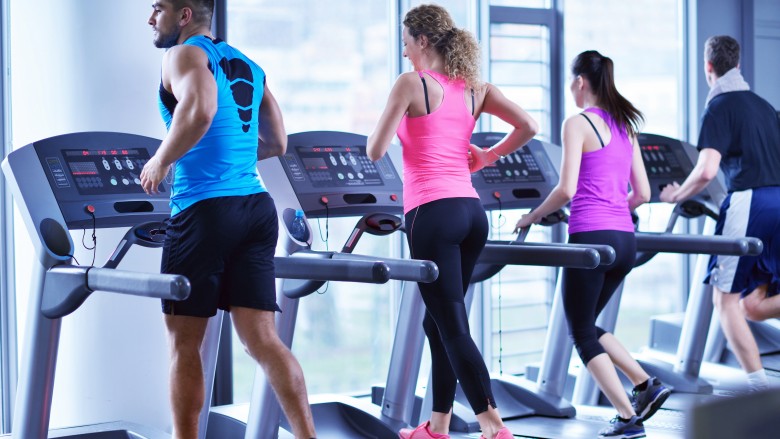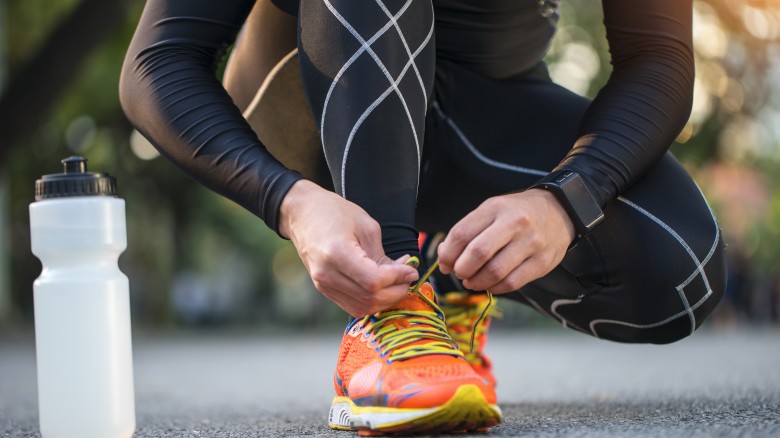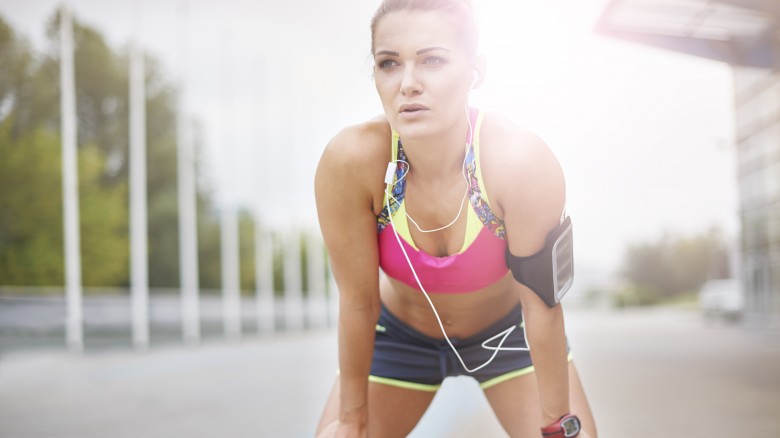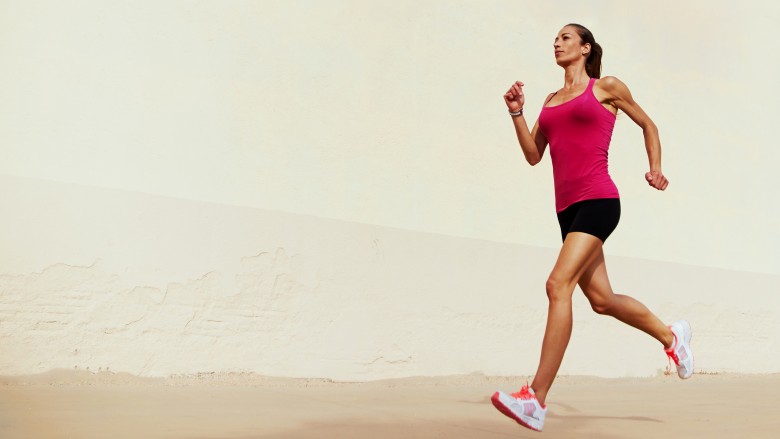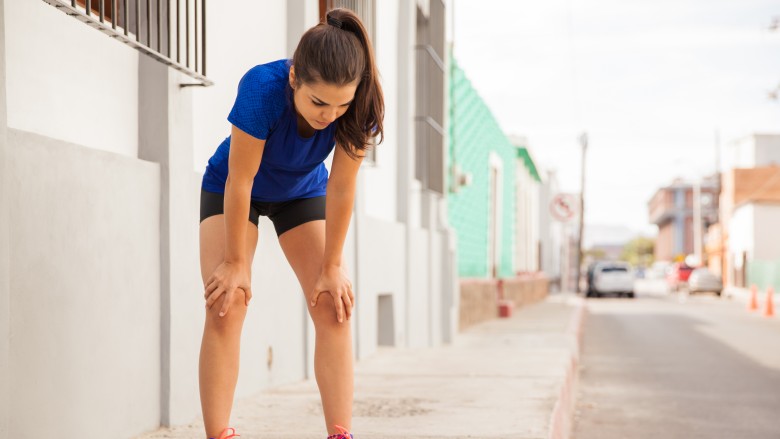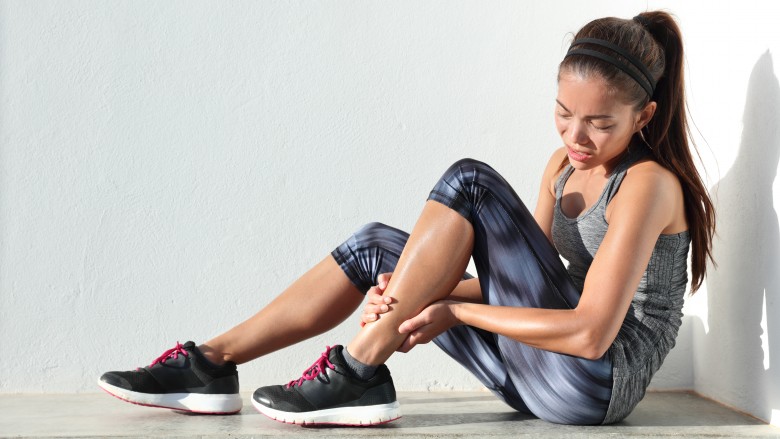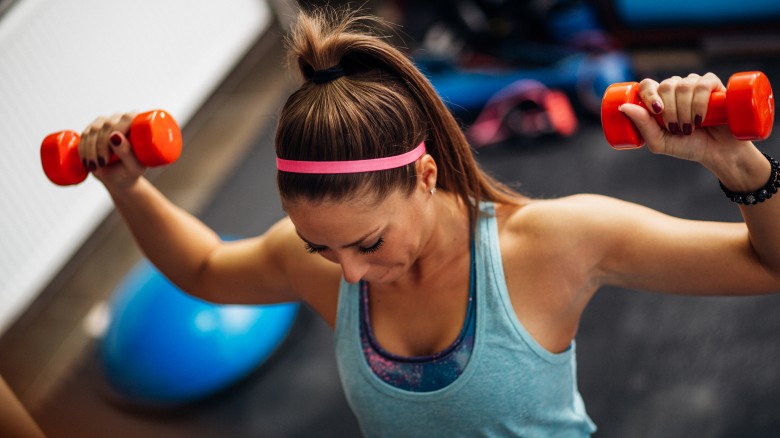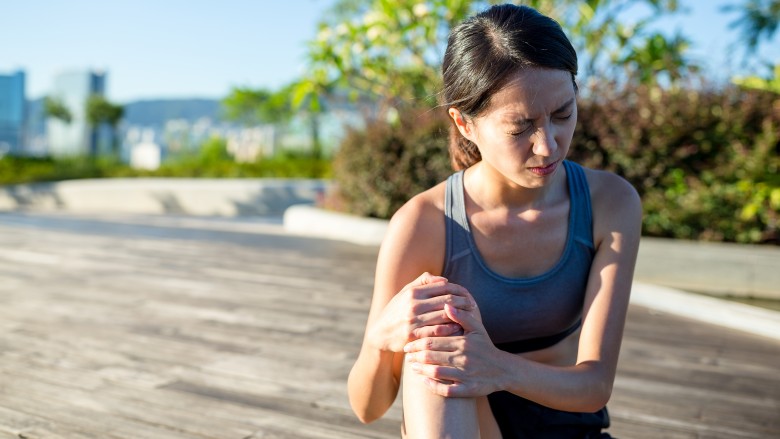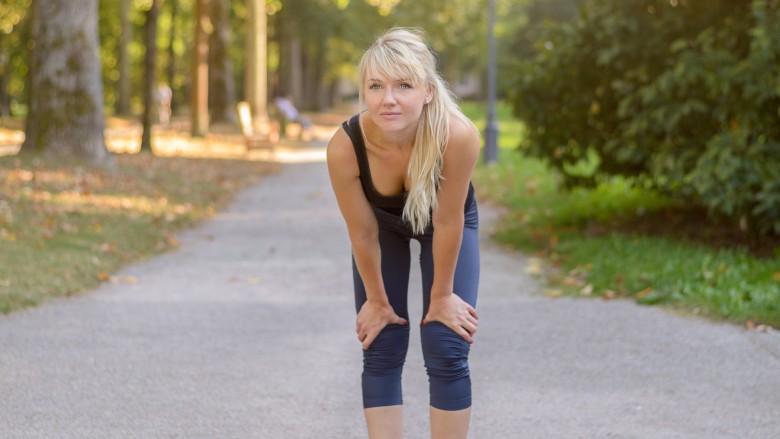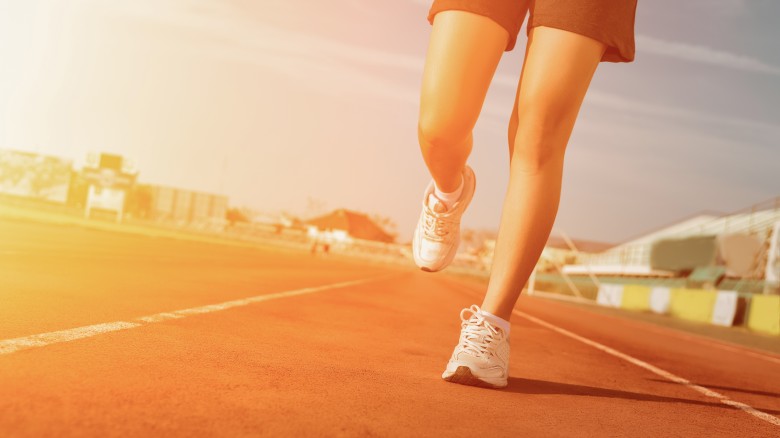Signs You're Jogging Incorrectly
When you're new to jogging, everything can feel a bit strange. You're not used to controlling your breath or pushing through that initial discomfort. This new jogging learning curve can leave us feeling defeated and ready to give up.
Once you find your groove, you may start looking forward to and even needing your jogs. Jogging is one of the easiest ways to work out. Simply lace up your sneakers and go. However, it can be dangerous if you're making some of these common running mistakes. Before heading out for your next run, check out 12 signs that your jogging needs a change.
Your neck is sore
When you run, make sure to focus on what's ahead of you, placing your gaze on the horizon. "Many people, when they first start running, tend to stare at their feet because they're trying to see what's going on down there," Cat Fitzgerald, DPT, CSCS, a physical therapist and running consultant at New York Custom Physical Therapy told Greatist. Looking down throughout your run puts unnecessary stress on your neck, leaving you feeling stiff and sore after your run.
Fitzgerald recommends looking straight ahead and trusting your own feet to follow along. "It'll protect your neck because when you're looking down your neck is flexed and then your posture collapses," she explained.
You're holding on for dear life
If you have ever jogged on a treadmill, then you know how tempting it is to grab those sides. Those attractive little railings are sitting there, just waiting to be leaned on. Resist! Holding on to the sides too tightly will not only throw off your posture, it robs you of your workout.
When you lean on the treadmill, you're putting more body weight into your arms and taking it off your legs. You definitely will not be burning as many calories as the treadmill says you are.
It's best to gently swing your arms, but never across your body's midline. Keeping your arms relaxed and slightly bent, use your arm stride to propel you forward. If you feel like your arm swing is causing you to rotate side to side, it's time to slow down. "Using a small and swaying arm drive can cause you to rotate, and can eventually lead to all kinds of problems," Los Angeles-based running coach David Siik told Women's Health. "A powerful leg and arm drive creates a great force that meets across your abdominals, giving you an incredible core workout — and a speedy path to a flat, tight stomach!"
You're working out before bed
Any workout is better than nothing. If you are only able to find time to exercise in the evenings, keep doing your thing. However, it seems that the morning exercisers are reaping all the benefits.
A recent study looked at the effects of exercising first thing in the morning, in the afternoon, and right before bed. "Much to our surprise, 7 a.m. exercise was better in terms of reduced blood pressure throughout the day and greater sleep benefits than exercise at 7 p.m., and there was little blood pressure or sleep benefit when exercise was done at 1 p.m.," says Appalachian State University's Dr. Scott Collier. "We don't yet know the physiological mechanisms that result in these changes, but we do know enough to say if you need to decrease your blood pressure and if you need to increase your quality of sleep, 7 a.m. is probably the best time to exercise." If you've always resisted the idea of waking up earlier, maybe try getting up just five minutes earlier tomorrow. Slowly work your way up until you have time to work out in the morning.
Your dogs are barking
If your feet are hurting every time you run, it's time to look at your shoes. One of the most common jogging mistakes is wearing the wrong shoes. "Many injuries of the feet and ankles can be traced back to ill-fitting shoes," Megan Leahy, DPM, a podiatrist at the Illinois Bone & Joint Institute in Chicago, told Fitness magazine. Dr. Leahy recommends keeping plenty of extra room in your shoes, and actually goes up to a size nine running shoe from her normal size seven.
Nothing will kill your new jogging routine faster than aching feet. "If your feet hurt because the shoes don't fit properly or you're not running in the perfect shoe, then you're certainly more apt to not continue with the program that you're beginning," Timothy Miller, MD, a sports medicine specialist at Ohio State University Wexner Medical Center, told Greatist. Dr. Miller also recommends going a size up when buying running shoes. You actually need some extra room in those running shoes to protect your feet.
Now that you have the right shoes, make sure you're replacing them often. "As a general rule, it's been said that a pair of sneakers should never see a birthday," Michele Favale, run ambassador for Lolë, told Yahoo. Replace your shoes about every 400 miles or so.
You're gasping for air
When you're a new runner, you may always feel out of breath when you run. You are using your body in a new way, and it's natural to feel like you're huffing and puffing. However, using your breath to keep you going is crucial for all runners and joggers alike.
A study in PLOS One found that the ideal breathing rate is to inhale over two steps, then exhale over two steps as you run. This rate allowed study participants to run further without becoming tired. "Finding your pace is crucial to having successful runs and starting out too quickly is one way to burnout," Favale says.
You're not exactly a yogi
Runners are known for being tight, especially in those leg muscles that get so much work, but if bending forward to touch your toes is a joke, there's a problem. We have to keep our muscles loose and relaxed to prevent running injuries. One of the most important parts of your jogging workout is the warm-up and cool down. You need dedicated time for stretching at every workout. Marnie Kunz, a running coach at the Lolë running club and RunStreet recommends dynamic stretching, or stretching as you move (as opposed to just sitting on the ground and stretching). "Dynamic stretching is a great way to get your heart rate up and your muscles stretched before a run," she told Yahoo.
You're too focused on the run
Many people can't get themselves to start jogging because of the mental hurdles. Responses like "It's just so boring" or "I hate the treadmill" are common. It's important to distract yourself with positive thoughts during your run. Focusing on how hard it is or how tired you feel will leave you dragging and maybe even quitting. "For less-experienced runners, it's helpful to distract themselves from the feeling of fatigue," Sari Shepphird, Ph.D., a sports psychologist, told Greatist. If you run with music, make sure you change up your playlist every so often to keep you motivated. If you prefer running with a buddy, look into a local running club. You may even meet a new jogging bestie!
If you go it alone on your jogs, think of some positive mantras for yourself. Studies have even shown that positive self talk on a jog improves your endurance.
The cramps are stopping you
Many new runners are stopped in their tracks the first time they experience a cramp. It's not uncommon for runners to notice their legs or sides cramping up. These cramps can seem to come out of nowhere, but they're actually avoidable. "Running cramps can be caused by shallow breathing, dehydration, a lack of electrolytes in your body, or something you ate or drank before running," explains Marnie Kunz. According to Michele Favale, leg cramps most likely mean dehydration. Make sure you're staying hydrated both on your run and throughout the day. If you feel a cramp in your side, you may be breathing wrong. Come back to your breath rate of inhaling for two strides, then exhaling for two strides. Finally, a stomach cramp can mean you ate too close to your run.
You're skimping on the strength training
When I trained for my first half marathon, I was running all of the time. Every workout included a little stretching and a lot of running. When race day came, I finished, but it nearly killed me. I hadn't built up the strength or endurance I needed to finish a distance race. The next time around, I wised up. I cut back on the running and went to yoga twice a week. I was a little nervous that I wasn't running enough, until the day of the race. I felt like I was flying through the course. Not only was I stronger, but I was better able to control and use my breathing.
Strength training is absolutely essential for runners. Not only will it make you stronger (duh), but you'll feel better when you're running and even avoid injury. Make sure to strengthen your running powerhouse muscles like your quads and glutes. Also focus on total body conditioning. Running requires a strong core to hold you up as you increase your distance.
Your knees are begging you to stop
Knee pain is all too common for both new and seasoned runners. Make sure your shoes are in good condition. If you're trying to run in old sneakers, the soles won't be absorbing some of that shock from hitting the ground like they should.
If your shoes are fitting properly, pay attention to what your knees are doing when you run. A common cause of knee pain for female runners is the knees falling inward as they jog. If you ever notice that it feels like your knees are touching when you jog, it's time to strength train. "When they [female runners] land on each leg, their knee will sort of dive toward the middle of their body so much so that their knees will knock or touch," says Cat Fitzgerald. This can come from weak glute muscles. Once your buns of steel give out, your thighs can rotate inward, causing your knees to touch. Focus on strengthening the glutes to protect those knees.
You curl forward as you run
After my first half marathon, I felt like I was on top of the world. I had accomplished a huge goal that I wasn't sure I'd be able to do. After the race, I was excited to see the pictures my parents had taken. What I wasn't expecting to see was a little old lady running in my place. In every picture I was completely folded forward. How did I not notice that? Why was I doing that?
According to Cat Fitzgerald, tight hip flexors were to blame. If your hip flexors are tight, you'll naturally lean forward as you go. The solution? Stretch those hip flexors during your warm-up. "It helps to turn on the glutes in the back and open up the front of the hips," Fitzgerald says.
You look like a gazelle
Looking like a sleek gazelle doesn't sound like the worst thing in the world, but you definitely don't want to run like one. Gazelles have those long strides, and while they look graceful, we humans are not meant to take such big steps. It's called overstriding, and it happens when you take such long running strides that your foot lands in front of your knee. Doing this feels heavy on your foot and is putting too much stress on your knees. Focus on keeping your knees soft and bent. Your foot should be landing underneath your knee as you stride.
So what should I do?
The great thing about jogging is that just about anyone can do it. All you need is a decent pair of shoes and a little motivation to go out and get a great workout. Don't let the fear of doing it wrong keep you indoors. Just go out with a plan.
First, focus on your body's alignment. Imagine there is an invisible string from the top of your head all the way down. Make sure your head is upright, not leaning forward or falling back. Your shoulders should feel relaxed, and your arms should be bent at about a 90 degree angle. Keep your hands relaxed in a loose fist.
When jogging, try to remember to keep your core engaged by pulling your belly button slightly in. This will not only strengthen your core, but will protect your back as well. Make sure your torso is upright or very slightly leaning forward, never to the point where you're bending at your waist.
If you ever feel like you're not able to keep up this alignment, just take a break. Either slow down your pace or stop and walk for a bit. It will be worth protecting your joints.



